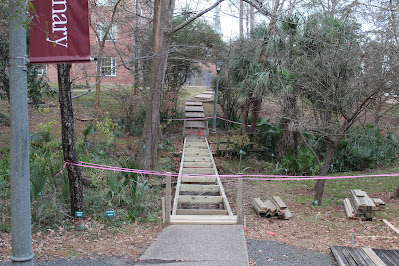 |
| This area is still a mess since the last time we worked on it. Projects like this must be repaired slowly, as the big chunks of clay are not easily moved, shaped, or broken up when they have any appreciable moisture content. Weather, uncontrollable and unpredictable as it is, can be a major inhibiting factor. |
 |
Leaves, on top and mixed into clods of clay, make for a very difficult work environment. It's hard to see what needs to be done since leaves can cover a gaping hole or simulate a mound of earth.
|
 |
Leaves of the swamp white oak (Quercus michauxii) comprise the bulk of the leaf litter.
|
 |
With the heavy leaf layer removed, we can see what needs to be
done. Much of the gravel has been washed down slope, exposing roots.
|
 |
Looks can be deceiving; it may not appear much different, but a lot of work went into leveling off these mounds of clay, smoothing out the slope, and generally re-sculpting the damaged terrain. Hopefully we have a few more days before another good rain soaks the ground, making the clay unmanageable.
|
In other news, a construction project is underway in the middle of the arboretum.
 |
The long white wooden bridge that runs between Mickel Hall and the Student Union Building was completely removed, and carpenters are now in the process of building a new structure. See pictures of the old bridge here.
|
 |
It takes a lot of material to build even the simplest infrastructure. Plenty of treated lumber is stacked nearby, waiting to be used.
|
 |
The bridge spans the arboretum's drainage channel. Currently there is standing water in the stream, but this area dries out during the summer.
|
 |
Some of the bridge's pylons are made of heritage brick. The rest are economical cinderblock.
|
 |
This treated lumber will need to withstand quite a range of weather conditions: hot, cold, wet, and dry. The previous bridge lasted more than two decades.
|
 |
We wish the workers a safe project and look forward to having a new bridge.
|










